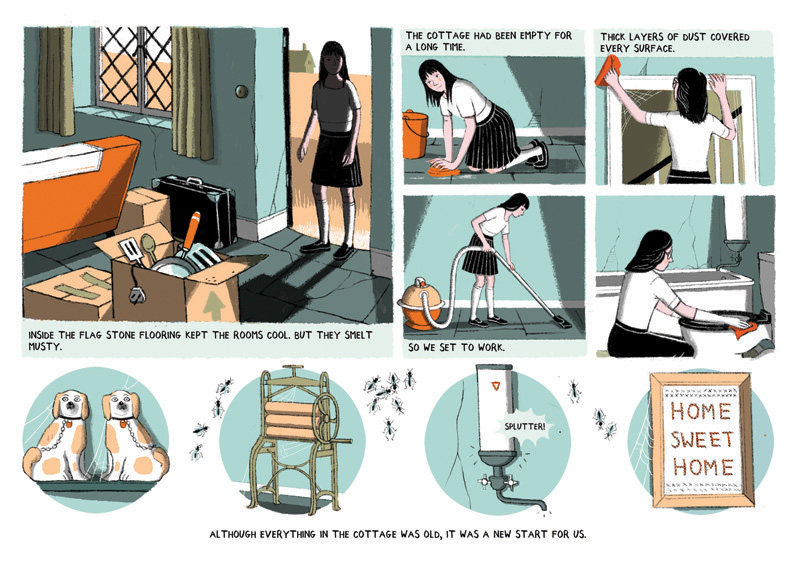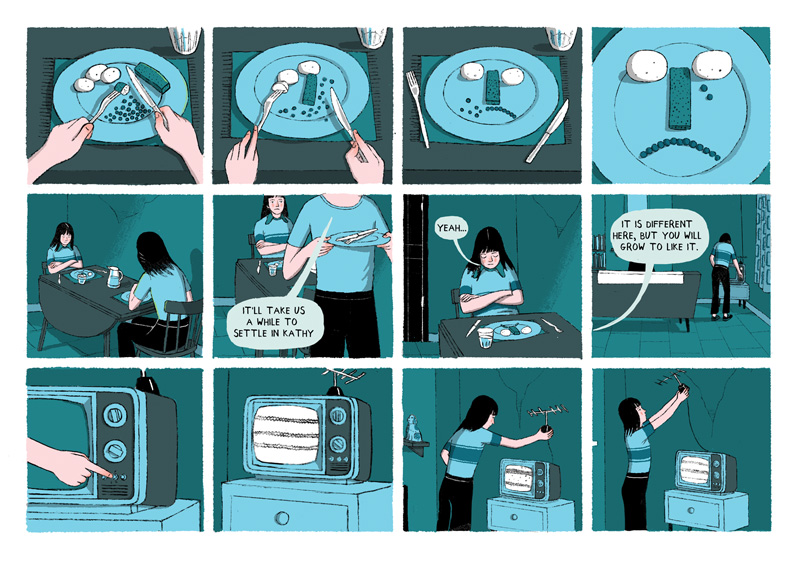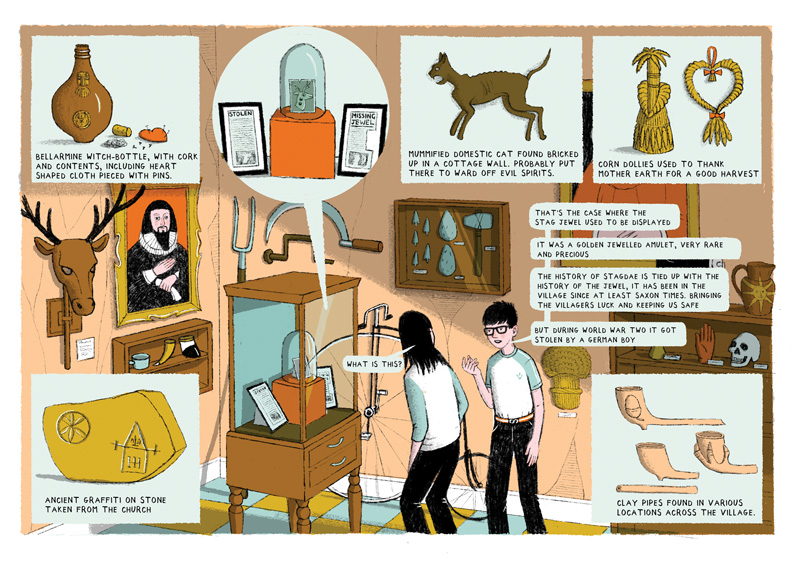Are you ready to take a trip to Stagdale? Prepare to enter a world of mystery and intrigue set in the stunning British countryside with Frances Castle’s atmospheric and visually arresting graphic novel.

It’s the summer of 1975 and despite the addition of a new housing estate the ancient village of Stagdale remains an insular place suspicious of change. Nestled into the chalk-scared valley lies Stagdale Manor, home to Lord Ethelbert, a self-proclaimed descendant of a Saxon King. Once grand, the estate is slowly slipping into a state of dilapidation. Hoping to find a new life for themselves, 12-year-old Kathy and her recently divorced mother rent an old damp cottage from Lord Ethelbert on the outskirts of the village.



It’s not long before Kathy befriends local boy Joe who enjoys telling her stories about village life, both past and present. He takes her to the museum and shows her the empty glass case where the Stag Jewel, a Saxon gold amulet in the shape of a deer’s head, used to be displayed. The jewel was thought to have once brought Stagdale prosperity and luck, but according to local legend it was stolen by a German boy who lived in Kathy’s house during World War Two.

REVIEWS for Stagdale
Review by Karl Andy Foster for the Association of Illustrators
“‘Last night I dreamed I went to Manderley again’. This quote from Daphne Du Maurier’s Rebecca comes to my mind when I reflect on the structure that Frances Castle has constructed for her tale of things remembered past. In the first part of Stagdale, nostalgia is as vivid as the swallows that dart about in the cauldron heat of the summer of 1975. The drawing style and character design of this credible world combines modulated lines with delicate textures and sumptuous colour with somber tones.
Kathy is uprooted from London by the acrimonious separation of her parents. She has arrived at the place where her mother’s ancestors come from so it’s part homecoming. The Brontésque atmosphere that Castle conjures out of the hot summer night sky takes me back to the tales I read as a boy and how my imagination soared when I thought of the mysterious world just beyond in the shadows.
Stagdale is the location deep in the Cumbrian National Park, a picture postcard, chocolate box English Village where all is not well. Castle employs a bright pastel palette for daytime and sultry inky one for night. Colour signifies much more than the passing of time in this story. While her mother concentrates on making a home for them, Kathy tries to cope in these unfamiliar circumstances. She finds some comfort in her friendship with Joe but the Bloat family who live opposite are proof that she’ll need to keep her wits about her. Working with the familiar tropes that represent English rural life and the stereotypes real or imagined that make things tick Castle positions Kathy into a world where there is an ancient wrong that must be investigated.
The layers of the story are further enhanced by the surprising discovery that many years ago another unhappy child lived in the cottage. Max a boy from Germany has hidden something in the cottage that takes us from rolling English hills to the mechanised jackboot of history. All is certainly not well!
This A5 landscape format aids the sweeping scene depicted on the front and back of the book. The narrative is enhanced by the delicate end papers that contain subtle nods to the events within. Frances’ illustrations are a treat for the eyes and it’s the beautifully crafted details that make this an impressive piece of work. Of particular note for me is the spread showing the centre of the village, with its austere war memorial and ubiquitous shopping trolley half submerged in the river. The village is well maintained on one side but not the other why is this? Inside the Stagedale Stores with its supply of long ago sweets and the strange shadowy figure standing in the back. The Stagdale museum scene with its pitiful contents is still however pregnant with clues. The use of familiar tropes such as lightening and rain help us to appreciate the tension and eeriness of the place especially at night time.
If you were alive in 1970’s Britain the fashions, sweets for sale and the pace of village life will be familiar to you even if you never lived in a village. There is the power of the cultural collective conscience at work here, something that has been lost in modern times. I look forward to reading further chapters from this story to see if Kathy can make a success of her new life, whether she will discover more about Max the German boy and what actually did happen to the Stagdale Jewel!”
“Stagdale is more than a lovely curio, its intersection of music and graphic storytelling offers a vivid experience and fresh possibilities” – Concrete Islands
“Now I’m itching for part 2 and beyond. It’s so good I just want to sit with each panel, soaking it in” – @sixty4k on Instagram
“I like very much the tension between the reassuring familiarity of the world Frances summons up with her images (in the spirit of Bawden and Ravilious) and the canker within – just as poisonous then as it is now.”- Kevin Crossley-Holland
Find out more about Frances and her work, check out her online portfolio HERE, visit her website HERE, follow her on Instagram and Twitter. Grab a copy of Stagdale HERE
The soundtrack to Stagdale …
Frances Castle set up the boutique record label Clay Pipe Music, to create beautifully designed and illustrated, limited edition vinyl LPs. The first part of Stagdale will be released through Clay Pipe along with a flexi disc and download EP of Moog based electronica by The Hardy Tree (Frances’ musical alter ego) that soundtracks the story.
You can listen to the Stagdale EP over on Spotify.. CLICK HERE



